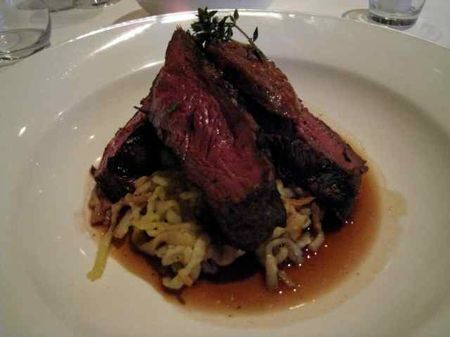Clare > Barossa
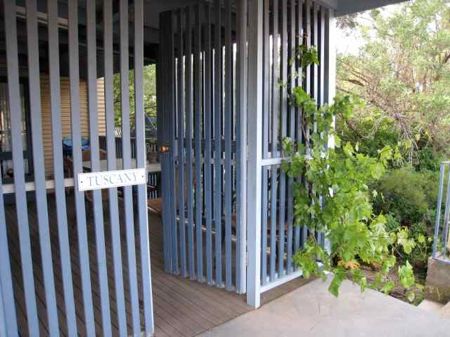
An early night was, as it turned out, undoubtedly the smart option. Through the night, the wind picked up, not enough to disturb the slumber at first, but in the predawn hours as the wind howled and the rain swept across in scuds of varying intensity a warm bed was the place to be.
Somewhere around two the wind dropped and the thunder moved in, eerie in the silence and threatening enough to make a return to sleep a difficult proposition. But with several hours of sleep already under the belt, lying half-awake listening to the rolls of thunder gave me a chance to think back over the previous couple of days.
Madam’s research activities had, once again, paid off.
She’d looked at a number of possibilities before booking us into one of the cottages that operate under the name of Lavender Blue. There are two cottages on site, one (Tuscany) occupying the upper level of the premises while the second (Provence) is tucked away on the lower level of the 130-year old building on the northern outskirts of Auburn.

We’ve stayed in as number of similar establishments in a variety of locations over the past few years, and while all of them had their own particular strong points, Tuscany was definitely among the very best of them. For some, the fact that the Main North Road runs past the front door might be a problem, but the passing traffic noise wasn’t enough to disturb a good night’s sleep.
Thunder, on the other hand, was a different proposition.
Each morning we’d managed a hearty breakfast from the provisions supplied and that was after we’d fashioned a light supper out of the supplies on the first night. There was plenty of room, the view from the upper levels of the building was wonderful and everything that we needed was on hand, even if an item sometimes took a little finding.
The presence of a sauna and access to bicycles were a definite bonus as well. If we’re back in the area and Tuscany is available I don’t see any point in looking elsewhere.
After polishing off the remaining breakfast ingredients, once we’d packed up and loaded the chariot, we headed off for a flying visit to Annie’s Lane before a side-track through Mintaro so we could try to get a couple of photos of Martindale Hall en route to the Barossa.
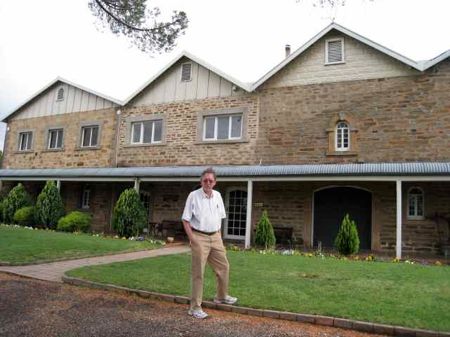
When we arrived at the old Quelltaler Winery (nowadays Annie’s Lane) we learnt the overnight weather had done a bit more than rumble ominously. Significant power outages between Clare and Auburn meant that we were probably lucky to have progressed as far as we had. The morning’s breakfast and ironing activities, in particular, would have been grossly hampered by lack of power.
The accommodation at Tuscany had come with a handy 20% discount voucher for use at Annie’s Lane, which was, to be honest, the main motivation for the visit (just in case we ran across anything interesting, you understand). In the end I ended up having a cursory taste of what was on offer. The range didn’t seem to be offering anything out of the ordinary and the wines are widely available and often discounted.
Everything I tried was sound, well-made and perfectly acceptable. I’d be happy with the Riesling if it turned up on a restaurant wine list, for instance. In our part of the world that’d be a likely prospect, but over the past couple of days I’d tried a number of wines that would, in my opinion, be much better investments when you’re looking at a dozen bottles you’re not likely to find at the local bottle shop.
We arrived at Martindale Hall to find the gates closed, and since they weren’t scheduled to open for another twenty minutes (all we wanted was a couple of photos, after all) we decided to bid a fond farewell to the Clare Valley and make for the winemaking big smoke.
The trip through Manoora, Riverton, Tarlee and Kapunda was totally uneventful apart from a mild degree of concern as to whether the fuel supply would hold out, and just before midday we turned off in Tanunda in search of parking and information.
On the way we’d passed Penfolds and a host of other wineries that it would probably be worth a visit, but a quick check in the Barossa guide book we picked up listed fifty-five wineries, so, working on, say, five a day we’d be looking at more than a week and a half if we were going to be visiting them all. As it was, we didn’t have a full day at our disposal before the car was due back in Adelaide.
In any case, after the previous three days in Clare any suggestion along those lines would have been tantamount to relationship suicide and I’d figured out that we could probably visit two without too much drama. The question was, under the circumstances, which two?
Which is where the research factor comes in.
Given the obvious numerical constraints I’d restricted my research to the places Mr Halliday had assigned five start, but that meant we were still looking at twenty-one wineries after I’d eliminated anything that wasn’t
It was obvious other selection criteria were needed.
For a start there was no way I wanted to pull into somewhere that was, even on a Friday afternoon, likely to be packed, which immediately ruled out some of the higher-profile establishments.
Many years ago I’d had the good fortune to come across a shiraz from Rockford and had been constantly on the lookout for any of their wines ever since, with absolutely no success whatsoever. Since, as far as I can make out, their distribution system doesn’t extend into our part of the world I figured Rockford was definitely one of the two to visit.
I’d also run across a number of references to Thorn-Clarke as one of the rising stars of the Australian wine industry and since it was close to the night’s accommodation I thought I’d found the second one.
That, however, was before I started looking at web-sites. Once I’d finished going through those there was only one choice - Seppeltsfield.
For a start I realised there was something lacking in my tasting experience and the something was the highest quality sherry-style wines produced in Australia. Looking at the photos on the web-site it was obvious the buildings and grounds would provide Madam with plenty of heritage-oriented photographic interest while I had a taste or two.
Once we’d picked up the guide book and the map it was time to think about lunch, but even before the German-accented lady had drawn a circle around it on the map, Madam had decided lunch was going to be a picnic basket from Maggie Beer’s Farm Shop. She’d also set her heart on trying the ice-cream there.
We drove out through light drizzle, parked and wandered indoors to find that the picnic basket was an eat-it-here affair of pate, dips and bread. There was an area where we could taste the pates on offer, and once we’d made our selection it was a case of grabbing a table overlooking the lake which, even through the drizzle, was a pleasure to behold.

I’d opted for the mushroom pate and a glass of the Beer Brothers Semillon Chardonnay for my lunch, while Madam’s preference was directed towards the red pepper version and a glass of non-alcoholic Cabernet.
Looking at the contents of each little basket you might feel that you’d need a bit more to keep you going for the rest of the day but I found that there was just enough to fill the yawning void without leaving you too bloated to be able to fit in a little liquid afterwards.
Madam picked up some ice-cream on the way out, planning to give it time to soften a little on the way to nearby Seppeltsfield. On the way we passed two wineries that my research suggested could well be worth visiting, but the game plan brooked no variation.
Approaching Seppeltsfield Madam was impressed by the hilltop Seppelt Family Mausoleum looking out across the valley, and by the avenues of huge ancient date palms along the way.
A momentary pause in the precipitation gave me the chance to duck into the tasting room while Madam sat in the car with the little container of ice-cream. Had the weather been finer she could have used the public park facilities beside the car park, but the weather gods looked like intervening at any moment, effectively ruling out that possibility.
Once safely inside the tasting area I took a stroll around the museum displays before sidling over to the business side of the facility.
Having been sold off by Fosters, Seppeltsfield is now owned by the same interests as Kilikanoon, and in the processes involved with the sale the stocks of table wines were separated from the fortified stocks. That meant while there were table wines available to taste, they were going to be much the same as some of the range I’d tasted at Kilikanoon the day before. There was, however, a 2005 Barossa Shiraz with an impressive long finish.
In any case, I wasn’t there for the table wines.

The starting point on the fortified trail was the Flora Fino (500mL $22), absolutely bone dry and the sort of wine that would make an excellent aperitif or an ideal accompaniment to a spread of tapas. It was made from Palomino, as was the excellent Clara Blanca Amontillado (500 mL $20), a wine which had, believe it or not, sixteen years in wood.
And it showed it.
The third sherry on offer was the Vera Viola Oloroso, a semisweet wine that is, or so I was told, more in the Spanish style.
These are wines that, as far as I can see, are flying under the radar as far as popular taste in Australia is concerned. In a way you’d almost hope they stay that way and never make a comeback.
If that were to be the case the aficionados might be able to quietly enjoy sipping away at some fine styles without breaking the bank but, on the other hand, there’s the danger they’ll disappear altogether if producing them becomes less attractive to the bean-counters who are starting to rule the roost in the upper echelons of the big wine concerns.
However, now I know what I’ve been missing I’ll be doing my bit to sustain them in the future.
Moving on to the Tawny side of things the Cellar No. 7 ($20) with an average age of five years was a light style that doesn’t need a log fire on a cold winter night while the Para Grand Tawny ($26) with an average age of ten years was wonderfully complex.
The sale of the winery and its large stocks of unfashionable fortifieds meant the new owners acquired substantial stocks of Rutherglen Muscat and Tokay and, as a lover of both there was no way I was going to be walking out without sampling what was on offer. The Cellar No. 6 Tokay and Cellar No. 8 Muscat (both $20) were great examples of the younger version of these great Rutherglen styles, while the Grand Tokay and Grand Muscat (both 500mL $32) were simply superb.
The ownership shakeout has resulted in changes to names and labelling but someone wandering into a bottle shop to find something under the Seppelts label at around the same price point will probably be looking at the same product,
Back in the car we made our way back to and through Tanunda on the way to my other must visit winery, Rockford Wines in Krondorf Road. Arriving outside the stonewalled compound Madam decided she liked the look of the place, an impression that was reinforced as we walked into the tasting room, which had the look and feel of an ancient cellar rather than some modern architect’s self-indulgent showcase.
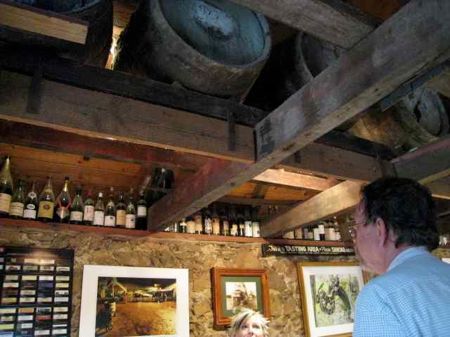
Which is the way I like it, because these places are supposed to be all about the wine. Multimillion dollar winery complexes are all very well, but you can’t help suspecting the showy exterior might, in some way, be an attempt to distract you from the wine which is supposed to be what it’s all about.
And these wines were, once again, stunning.
The 2006 Hand Picked Eden Valley Riesling ($19) was excellent. Loads of flavour, a lovely finish, a match for anything we’d tried over the previous couple of days. Even better was the 2004 Local Growers Semillon, an aged style that, in the words of the cellar door tasting notes invites itself to lunch. At $18 I suspect I’ll be inviting some into the wine rack.
The 2008 White Frontignac ($15.50) had a touch of sweetness without being cloying, much like the Gewurztraminers we’d tried in Clare, and was another wine that would go well with spicier dishes.
Moving on to the red side of things, the 2008 Alicante Bouchet is a lovely light summer red, an almost ideal Rose style without any sweetness. One to chill and chill out over while nibbling on a Christmas/New Year lunch. One of my first acts on returning home was to order a case.
The 2004 Moppa Springs (47% Grenache, 40% Mataro 13% Shiraz $23.50) was nicely complex with a fantastic rounded mouth-feel and a joy to swirl slowly around the palate. One to savour.
The 2005 Rod & Spur ($29.50), named for the traditional pruning method, was a huge wine that took absolutely no prisoners but was surprisingly mild for its size, while the 2005 Rifle Range Cabernet Sauvignon was another big full-bodied style with real cabernet character, huge and earthy but still mild with it. Fantastic.
It isn’t usually available for tasting but there was an opened bottle of the 2001 Shiraz VP ($62.50) so we had the chance to try an absolutely stunning wine that should last for years. One to buy and lay down for a 50th birthday (assuming you have offspring born in 2001) or, maybe those of us born in ‘51 might think about laying one down if we’re confident of making it to the century mark.
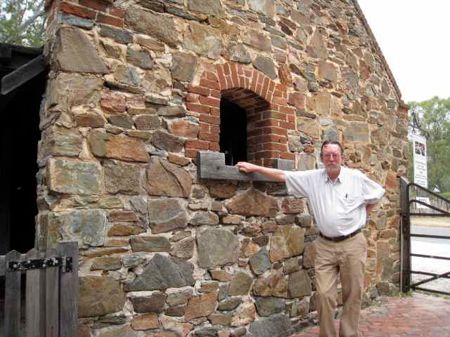
I was more than happy with the state of the world when we headed away from Rockford, following the Scenic Heritage Drive, but the weather conditions didn’t favour sightseeing so Madam suggested that I might like to visit another winery, which provided the opportunity to readmit Thorn-Clarke to the tasting schedule.
The winery, located east of Angaston, is slightly out of the way and as we pulled into the car park I wondered, surveying the list of mining-related companies beside the door, whether we’d come to the right place, but once we’d been directed through the door on our left it was obvious that we had.
The Thorn-Clarke core range ($15) comprised wines that were consistently excellent, starting with the 2007 Sandpiper Riesling, a really cool-climate style made from Eden Valley fruit. The 2007 Sandpiper Pinot Gris was, predictably, in the French rather than the Italian style with strong pear flavours and the 2006 Sorriso Rose, a blend of Nebbiolo and Cabernet was a dry, easy-drinking style. Another one for a summer afternoon.
Of the core range reds the 2007 Sandpiper Shiraz ticked all the right boxes and the 2007 Sandpiper Cabernet Sauvignon was an excellent easy-drinking wine, as was the 2005 Sandpiper The Blend (Shiraz, Petit Verdot and Cabernet Franc).
Further up the price range in the premium wines, the 2007 Shotfire Chardonnay ($20) was on the buttery side of the spectrum (the style I really like) and the 2007 Pinot Gris ($20) was surprisingly similar despite the fact it hadn’t undergone the malolactic fermentation that usually leads to those characters. Interesting.
From there it was a matter of checking into the night’s accommodation at the Vineyards Motel, an unprepossessing establishment that had the advantage of being directly across the road from Vintners Restaurant, the venue we’d selected for dinner, and the adjacent Saturday morning Farmers’ Markets.
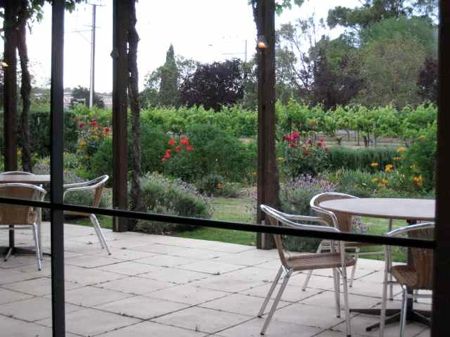
Dinner was a pleasant affair, with the chicken (Madam) and kangaroo versions of the daily specials. I chose a glass of Tin Shed Cabernet Franc ($9) to go with the ‘roo, though the most memorable bit of the evening came after we’d started the walk home, which quickly became a run as we crossed Stockwell Road, closely pursued by the rain that had been threatening to do something more than drizzle all day and had waited till we were on foot in the open to do so.
